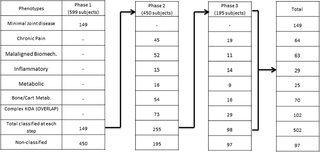PLOS ONE ( IF 2.9 ) Pub Date : 2018-01-12 , DOI: 10.1371/journal.pone.0191045 A Dell'Isola 1 , M Steultjens 1

|
Objectives
The existence of phenotypes has been hypothesized to explain the large heterogeneity characterizing the knee osteoarthritis. In a previous systematic review of the literature, six main phenotypes were identified: Minimal Joint Disease (MJD), Malaligned Biomechanical (MB), Chronic Pain (CP), Inflammatory (I), Metabolic Syndrome (MS) and Bone and Cartilage Metabolism (BCM). The purpose of this study was to classify a sample of individuals with knee osteoarthritis (KOA) into pre-defined groups characterized by specific variables that can be linked to different disease mechanisms, and compare these phenotypes for demographic and health outcomes.
Methods
599 patients were selected from the OAI database FNIH at 24 months’ time to conduct the study. For each phenotype, cut offs of key variables were identified matching the results from previous studies in the field and the data available for the sample. The selection process consisted of 3 steps. At the end of each step, the subjects classified were excluded from the further classification stages. Patients meeting the criteria for more than one phenotype were classified separately into a ‘complex KOA’ group.
Results
Phenotype allocation (including complex KOA) was successful for 84% of cases with an overlap of 20%. Disease duration was shorter in the MJD while the CP phenotype included a larger number of Women (81%). A significant effect of phenotypes on WOMAC pain (F = 16.736 p <0.001) and WOMAC physical function (F = 14.676, p < 0.001) was identified after controlling for disease duration.
Conclusion
This study signifies the feasibility of a classification of KOA subjects in distinct phenotypes based on subgroup-specific characteristics.
中文翻译:

膝骨关节炎患者临床表型的分类:来自骨关节炎倡议的数据
目标
假设表型的存在可以解释膝骨关节炎的巨大异质性特征。在之前的文献系统回顾中,确定了六种主要表型:轻微关节疾病(MJD)、生物力学失调(MB)、慢性疼痛(CP)、炎症(I)、代谢综合征(MS)以及骨和软骨代谢(业务连续性管理)。本研究的目的是将膝骨关节炎 (KOA) 患者样本分为预定义的组,这些组的特征是与不同疾病机制相关的特定变量,并比较这些表型的人口统计和健康结果。
方法
24 个月时从 OAI 数据库 FNIH 中选取了 599 名患者进行研究。对于每种表型,根据先前该领域研究的结果和样本的可用数据确定了关键变量的截止值。选择过程包括 3 个步骤。在每个步骤结束时,分类的受试者被排除在进一步的分类阶段之外。符合一种以上表型标准的患者被分别分为“复杂 KOA”组。
结果
84% 的病例表型分配(包括复杂的 KOA)成功,重叠率为 20%。 MJD 的病程较短,而 CP 表型的女性人数较多 (81%)。在控制疾病持续时间后,发现表型对 WOMAC 疼痛 (F = 16.736 p < 0.001) 和 WOMAC 身体功能 (F = 14.676,p < 0.001) 具有显着影响。
结论
这项研究表明根据亚组特定特征对 KOA 受试者进行不同表型分类的可行性。











































 京公网安备 11010802027423号
京公网安备 11010802027423号